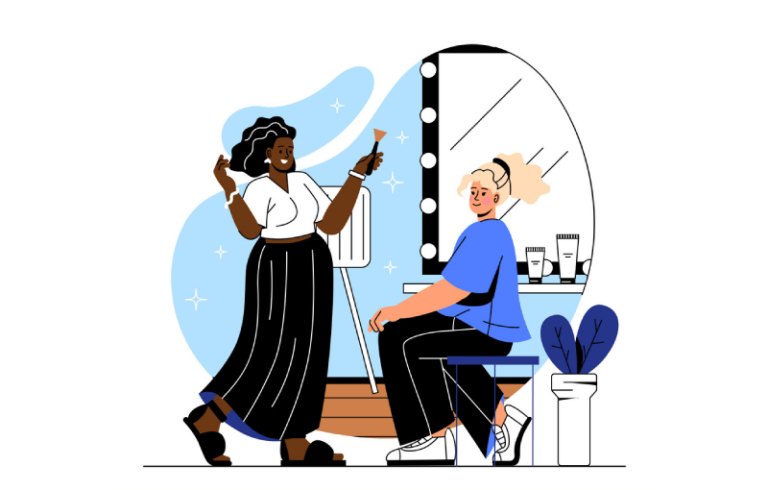Are you considering starting your own salon? Good choice! The beauty salon industry is expanding rapidly; according to Statista Research, the industry has leaped from $42 billion in 2020 to $54 billion in 2022.
Needless to say, there’s money to be made for salon owners, but the question is how much? Although the question “How much do beauty salon owners make?” may seem simple, it actually goes much deeper; the question would be better put as: “What makes a successful salon business?” This means considering potential business strategies and potential beauty services, along with the average salon owner’s income.
If this sounds complicated, don’t worry. This article is here to help fill you in on the average salon owner’s salary and the costs involved with a salon business, as well as to provide insights into how to run a successful beauty salon.
How Much Do Beauty Salon Owners Make?
To start this article with a bang, here’s the big question. How much do beauty salon owners make? The answer is (drumroll please) a national average of $29,658 per year, according to Indeed.com.
Even so, it is important to remember that this number is just an average. In reality, a salon owner’s salary can vary greatly, depending on many factors. For example, does the salon have a good location? How many salon employees do they need to pay? What are the overhead costs?
These potential differences mean that how much salon owners make can depend on their choices. There is no one set income for salon owners.
This potential variation means that salon owners can influence their income by making choices that benefit the business.
How Profitable Is a Salon?
Usually, the true profit margin for a beauty salon (or any business for that matter) is the percentage of revenue that remains after deducting all of your expenses. Needless to say, the higher the profit margin, the higher the profits.
According to Startup Opinions, the average beauty salon has a profit margin of around 8.2%. But remember, this is an average. In reality, your profit margin could range from 2% to 17% depending on effective management.
But that’s not all that can factor into a salon’s profitability. Profit can also depend on important factors like your salon’s location, the size of your customer base, and the services you offer. Luckily, most salons are projected to grow more profitable in the future, as the salon industry as a whole has recently begun to recover from the pandemic. To exemplify this, Statista reports show that the U.S. salon market has reached $53.6 billion in 2022, a big jump from $42.3 billion in 2020.
If you’re trying to decide on which salon business is the most profitable, hair salons and spas tend to win for profit margins. However, regardless of the type of salon, keep factors like rent, inventory, equipment, payroll, and other overhead costs in mind, as these can all have a large effect on the profitability of a salon.
What Is the Break-Even Point for a Beauty Salon?
The break-even point is the point when a salon earns enough revenue to cover all expenses, creating zero profit. You can calculate the break-even point by dividing your total fixed costs (constant bills that don’t change, like rent and insurance) by the contribution margin ratio.
If you’re wondering what the contribution margin ratio is, don’t worry, it’s quite simple. It’s the amount of revenue you have left after taking away variable costs. Unlike fixed costs, variable costs change depending on how many customers you have. Examples of variable costs would include supplies, commissions, and any other service expenses.
What Is the Average Turnover for a Beauty Salon?
Although the two may sound similar on paper, turnover and profit are two very different numbers. Both are equally important for business and require an equal amount of consideration.
Now, turnover refers to the entire gross income of a business) from either services or retail sales. It’s an important indicator for determining success, as it can better demonstrate your entire business’s income, instead of your own personal profits.
To illustrate what turnover refers to, here’s an example. Let’s say your salon is doing pretty well and bringing in 1,000 clients a month. Estimating that your average client is spending $46 on a visit, your gross revenue (or turnover) would amount to $46,000 every month. This would add up to a $552,000 turnover per year, a sizable amount when not considering costs.
Salon Business Owner Salary Factors
Although, as previously stated, there is no fixed salary for beauty/hair salon owners, there are some factors that can have an influence on your business’s success.
Of course, one of the biggest factors in your salary is the size of your salon. A large salon is going to generate a higher revenue than a small one, which translates to higher salaries for salon owners.
Another important factor is location.
Salons located in popular, heavily-trafficked areas can earn higher sales and thus gain an increased income for the salon owner. This is because these salons may receive more customers. However, areas can be a double-edged sword, as popular locations can lead to increased rent, which increases your expenses. Less popular areas may require fewer financial resources to pay rent or taxes, resulting in lower spending costs.
Another important factor is your salon’s services. Salons that offer haircuts, styling, coloring, and tanning services are often able to find more income than those with basic services. This is because a wider range of services can attract a larger client base, as they can cater to client needs.
Improving Salon Effectiveness
Now that you understand all there is to know about salon owners’ salaries, all that’s left is to improve your business. Here are a few ways to do it:
Reducing salon operation costs
First of all, how much you make isn’t as important if it’s all eaten up by salon expenses. To ensure this doesn’t happen, you need to set specific cost limits to make sure that your salon isn’t losing money anywhere.
And yes, this is not the most fun task. Nobody likes cutting down costs and optimizing processes, but it is vitally important to the success of your business. This can particularly be the case if your salon is growing at a fast rate, as unnecessary costs can easily fall under the radar.
The good news is, cutting down on fixed costs, like salon insurance, is simple, and it can improve your profit every month.
Here are some other simple ways to lower your expenses:
- Negotiate better deals with landlords or suppliers
- Reduce inventory and waste
- Outsource or automate some functions and tasks
- Hire and train more skilled and efficient staff
- Take advantage of incentives or tax deductions
Adding more salon revenue streams
When trying to grow your business, try to look past the slow, incremental growth involved with individual streams of income. Instead, look for new and innovative ways to make money through additional sources of revenue.
One example of this would be by offering add-on services like eyelash extensions, makeup applications, or hair extensions. You could also sell retail products like beauty accessories, styling tools, or hair care products.
You could also team up with other local businesses for cross-promotions for additional income. As an example, you could collaborate with a local spa or clothing store to offer package deals that would attract new clients and increase sales.
With multiple sources of income behind you, your business will do more than simply grow faster. You will also reduce the chance of a total business failure in the future if one source of revenue dries up.
Using the right software
Running a salon can feel like a wild rollercoaster ride. One minute you’re soaring, the next, you’re just scraping by. If you’re looking for a steady climb towards higher profits, let’s introduce you to Trafft.
Say goodbye to just getting by and say hello to a steady stream of cash flowing into your business. How? Well, Trafft isn’t your regular salon software. It’s your partner in profit.
Here are the features that set Trafft apart:
- Boost your bookings: Trafft fills up your calendar without you having to lift a finger. More bookings mean more bucks, right?
- Reduce no-shows: Automatic reminders mean clients won’t forget their appointments. Say adios to lost revenue from missed bookings.
- Upsell effortlessly: Offering extra services or products? Trafft helps you promote them to your clients without breaking a sweat.
Thinking, “Surely it can’t be this simple”? You better believe it. Trafft isn’t just another software. It’s a moneymaker.
Trafft is in your corner. It’s got your back. It knows your hustle, your struggle, and your ambition. It’s like having a business coach, pushing you towards success.
Your clients will fall in love with Trafft too. Easy booking, timely reminders, simplified payments. They’ll be over the moon, and a happy client is a loyal client. Loyal clients? They bring in the big bucks.
With Trafft, you’re not just opting for software. You’re embracing a higher level of business. You’re welcoming more profits, more satisfied clients, and less stress.
Ready to join the ride? Take a step forward with Trafft, and watch your salon’s revenue skyrocket. It’s time to move from scraping by to soaring high.
Trust me, you’ll be grinning all the way to the bank. Catch you on the flip side!
FAQ on How Much Beauty Salon Owners Make
What is the average income of a beauty salon owner?
Income for a beauty salon owner can vary widely based on a variety of factors. These can include the salon’s location, the number of clients, the types of services offered, and the overall business model.
On average, salon owners might make anywhere from $30,000 to $100,000 per year, but it’s important to note that individual results can vary.
How do beauty salon owner salaries compare to other professions?
Salon owner salaries can vary a lot, and it’s challenging to compare to other professions. They are entrepreneurs, so their earnings are tied to the success of their businesses.
Some salon owners might make less than professionals in other industries when they’re starting out, but there’s also the potential to earn significantly more with a well-run, popular salon.
What factors impact how much a salon owner makes?
A variety of factors can impact a salon owner’s earnings. These can include the salon’s location, its clientele, the number of employees, the types of services offered, and the overall success of the business. It’s also affected by the owner’s ability to effectively manage and market the salon.
How can a beauty salon owner increase their income?
Increasing income can be achieved by attracting more clients, offering high-end services, selling retail products, and effectively managing expenses.
Salon owners could also consider renting out chairs to independent stylists, which can provide a steady income stream.
How does the location of the salon impact an owner’s earnings?
Salon location plays a significant role in earnings. A salon located in a high-income area or city center might be able to charge more for services than a salon in a small town or suburban area. The location also affects foot traffic, visibility, and overall client base.
Does the size of the salon affect an owner’s income?
Yes, the size of the salon can impact an owner’s income. Larger salons might be able to serve more clients and offer a wider range of services.
However, they also come with higher operating costs. It’s about finding the right balance for your market and business model.
How does offering various services affect a salon owner’s income?
Offering a variety of services can potentially increase a salon owner’s income by attracting a broader client base. Services like hair coloring, extensions, and specialty treatments can command higher prices than basic cuts and styles.
What impact does selling retail products have on a salon owner’s earnings?
Selling retail products can significantly boost a salon owner’s income. Retail sales offer a high-profit margin and can be a consistent income stream.
They can also enhance the salon experience for clients and provide added convenience.
Does the number of employees impact a salon owner’s income?
Having employees can affect a salon owner’s income. More stylists can mean serving more clients and offering more services.
However, this also comes with added expenses for salaries, benefits, and training. It’s important to manage staff levels carefully to maximize profits.
How do salon owners earn money if they also work as stylists?
Salon owners who also work as stylists have two income streams. They earn money from their clients as any stylist would.
Plus, they receive profits from the overall salon operations, including services provided by other stylists, product sales, and chair rental fees if applicable.
How Much Do Beauty Salon Owners Make, and How Much Can You?
Owning your own beauty salon can prove to be a very profitable adventure. However, the amount you make is not set, and it can change greatly depending on factors like planning, management, and location.
This means that improving your salon’s profits is completely in your hands. If you plan well, manage well, choose a good location, and utilize Trafft, you can create a profitable business.
And this is why the question “How much do beauty salon owners make?” is a difficult question to answer. The better question is, “How much will you make?” No doubt, if you follow the advice outlined in this article, your business can find success.
If you enjoyed reading this article about how much beauty salon owners make, you should read these as well:
- How to Make Your Salon More Profitable With Trafft?
- Salon Booth Rental Tips and Best Practices to Know
- What Qualifications Do You Need to Open a Beauty Salon?





